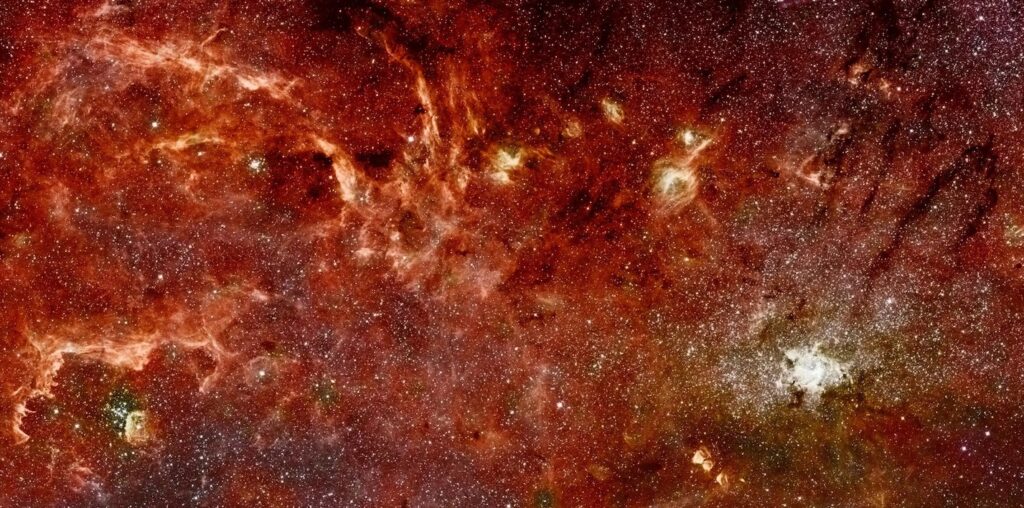
Hubble: NASA / ESA / and Q.D. Wang (University of Massachusetts, Amherst); Spitzer: NASA / Jet Propulsion Laboratory / S. Stolovy (Spitzer Science Center / Caltech)
Main-sequence stars with brighter than expected mid-infrared emission can signal the presence of a debris disk, rubble from planetary collisions, or even a theorized sign of a technologically advanced civilization. New research demonstrates a data-driven method to identify mid-infrared excesses in main-sequence stars.
An Excess of Emission

ALMA (ESO / NAOJ / NRAO); Visible light: NASA / ESA Hubble Space Telescope / A. Fujii / Digitized Sky Survey 2. Acknowledgment: Davide De Martin (ESA / Hubble); CC BY 4.0
Young stars swaddled in gas and dust are known to shine extra brightly in the mid-infrared, but as stars age, this mid-infrared exuberance is expected to fade. When it doesn’t, that signals something interesting. Extreme debris disks resulting from collisions between planets or planetesimals provide one explanation for excess infrared light from mature stars; as rubble and dust billow from the collision, the dust captures and reprocesses the star’s light, re-emitting it in the mid-infrared and causing a potentially detectable excess. Only a handful of extreme debris disk candidates have been identified.
Mid-infrared excesses are hypothesized to signal something even wilder: the presence of a Dyson sphere — a hypothetical artificial structure created by an advanced civilization to harness the power of their home star. Similar to dust and rubble, the components of a Dyson sphere would collect starlight and re-emit it at infrared wavelengths, potentially producing a mid-infrared bump.
Regardless of the cause, excess mid-infrared emission from mature Sun-like stars is something to investigate. But how do we find stars with this feature?
Taking Cues from Data
Gabriella Contardo (International School for Advanced Studies, Italy) and David Hogg (New York University; Flatiron Institute; Max Planck Institute for Astronomy) began their search for mid-infrared excesses with an expansive set of observations from the Gaia spacecraft, the Two Micron All Sky Survey, and the Wide-field Infrared Survey Explorer (WISE). After trimming these data sets down to include only main-sequence Sun-like stars, and to exclude objects that might be contaminated by close neighbors or are too dusty, they reduced the number of stars in their sample from 18,751,187 to 4,898,812.

Adapted from Contardo & Hogg / Astronomical Journal 2024
To identify mid-infrared excesses in this sample, the team needed an estimate of what the mid-infrared fluxes of these stars should be. Rather than using models, which can be computationally intensive and require making assumptions about the objects, Contardo and Hogg let the data lead the way.
Their data-driven method involves splitting the five million stars into eight sub-samples, each of which is used to train a separate random forest algorithm. Each algorithm “learns” what the mid-infrared emission “should” be from the stars in its sample, then predicts the mid-infrared emission of the stars in the other seven sub-samples. When a star’s actual mid-infrared emission is brighter than predicted, it gets flagged.
To Be Continued

Contardo & Hogg / Astronomical Journal 2024
This analysis yielded a preliminary sample of 127 objects with mid-infrared excess. Ultimately, after applying additional cuts to remove crowded objects, duplicate sources, and other complications, Contardo and Hogg landed on a sample of 53 objects with interesting infrared behavior. These objects’ mid-infrared emission ranged from 0.5% to 10% higher than expected, spanning the values predicted for extreme debris disks and rubble left over from planetary collisions. In fact, one of the 53 objects has already been highlighted by previous work as an extreme debris disk candidate.
What happens now? To identify the stars that are the most promising hosts of extreme debris disks, Contardo and Hogg listed ways to pin down the ages of the stars in their sample, which may rule out stars whose mid-infrared excess is due to their youth. They also proposed to compare the mid-infrared behavior of their stellar sample to Dyson sphere models, exploring whether the observed stellar behavior matches the predictions for these hypothetical structures.
Citation
“A Data-Driven Search for Mid-infrared Excesses Among Five Million Main-Sequence FGK Stars,” Gabriella Contardo and David W. Hogg 2024 Astronomical Journal 168 157. doi:10.3847/1538-3881/ad6b90
This post originally appeared on AAS Nova, which features research highlights from the journals of the American Astronomical Society.

